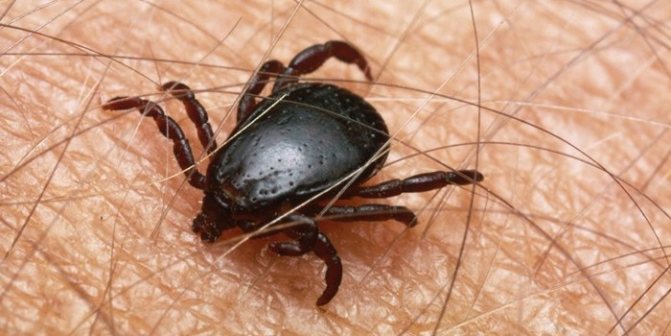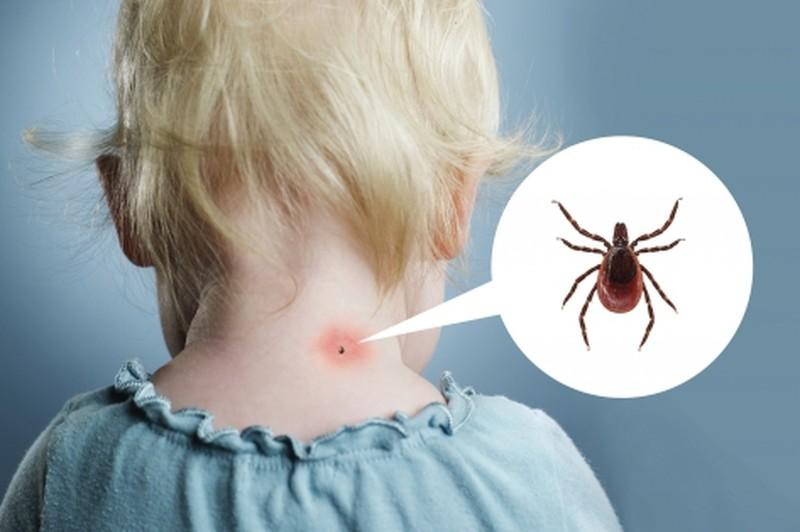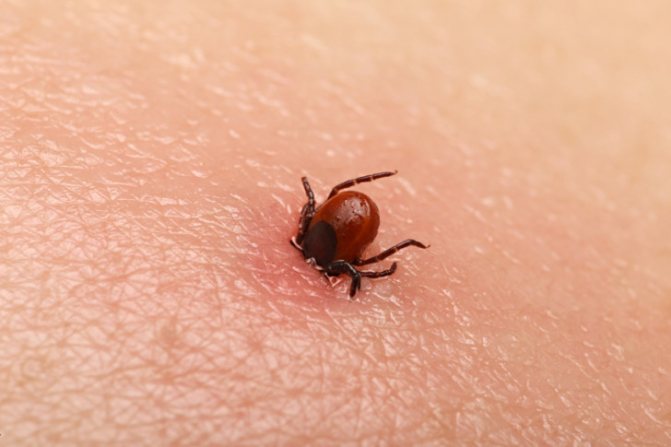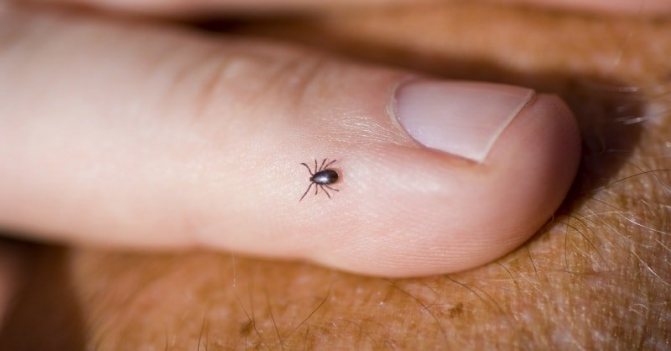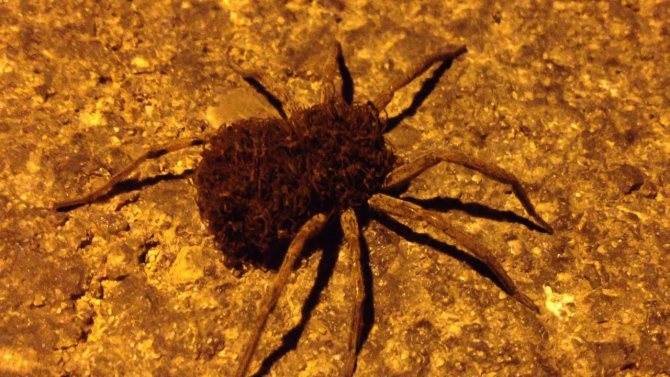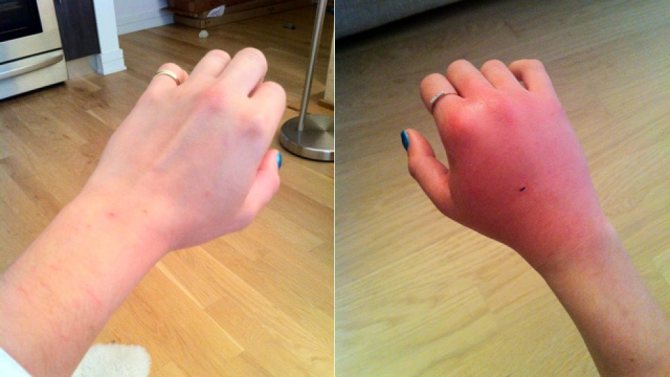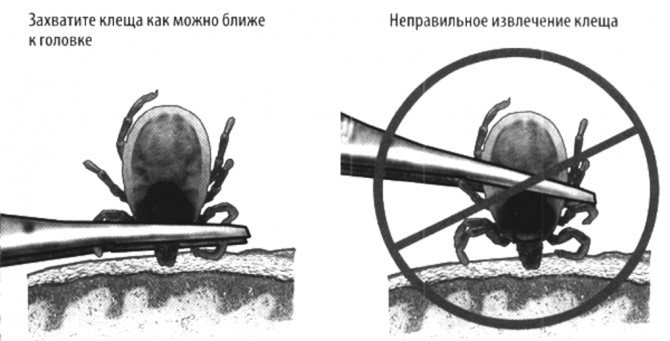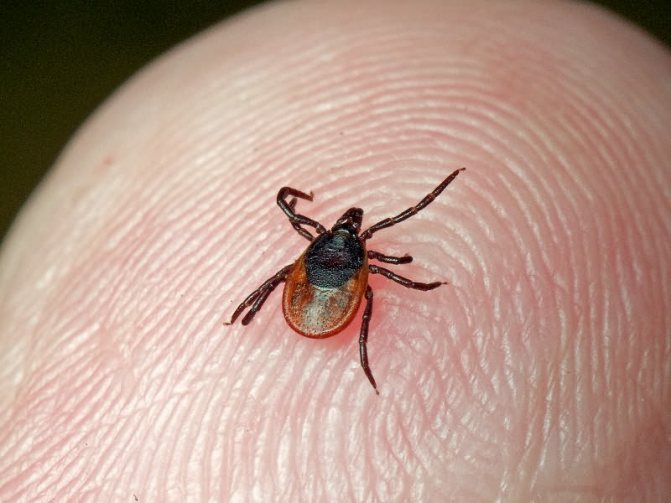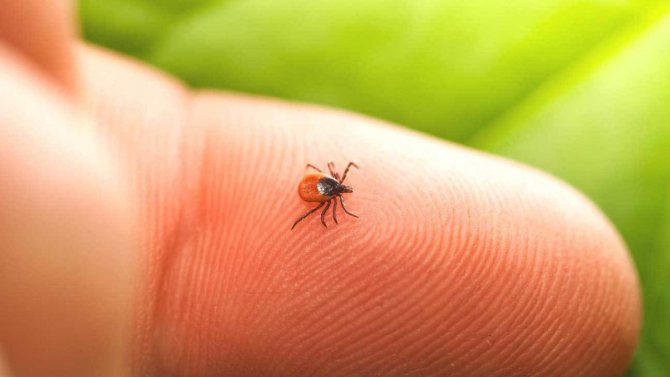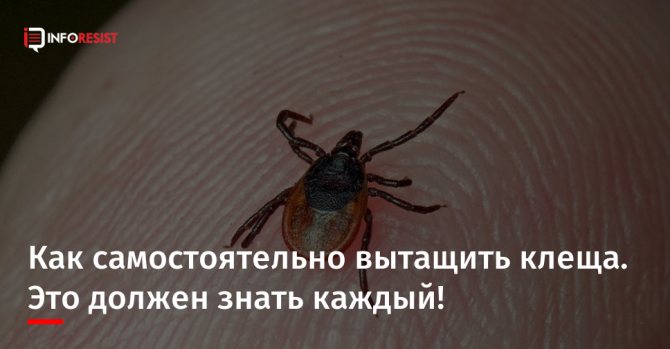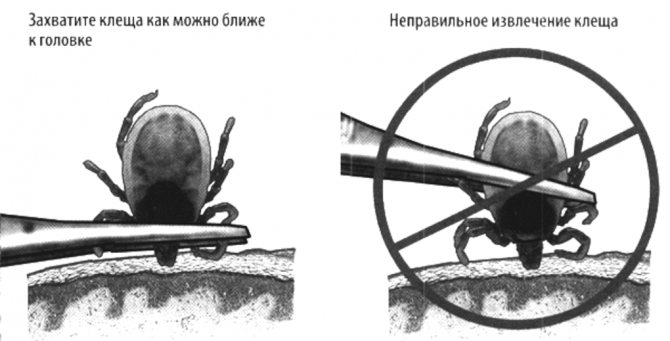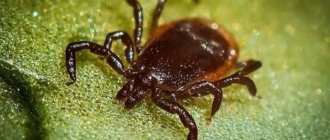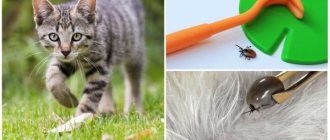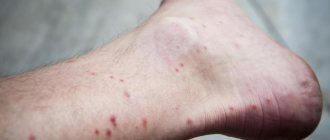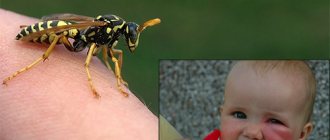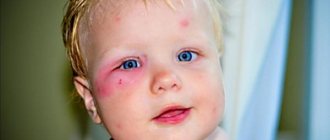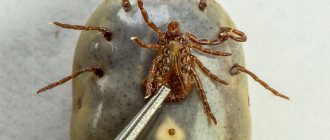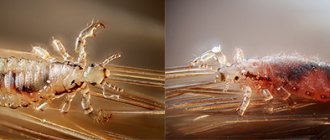Ticks not only bite and suck blood, but also carry infectious diseases. They are especially dangerous for children and newborns, because the baby's immunity is still too weak and is only adapting to new living conditions.
In many Russian regions, tick activity is already manifested in April and continues until October. They live in low shrubs and grass, they are found in forests, city parks and in suburban areas. The mite easily adheres to clothing and then sticks to the skin.
It is difficult to recognize a tick bite, since it is not noticeable and does not cause pain at first. The insect digs into the skin, sucks blood and saliva, which can infect. Therefore, it is important to identify and remove the tick in a child, newborn and adult at the time.
What does the tick and the place from its bite look like?
There are many varieties of this small arthropod insect around the world, but we will talk about the species that live in our latitudes. The most common is the so-called forest tick, which feeds on human blood.
This insect is very small in size, although the length of its body can reach 2.5 cm. The most dangerous are tiny (larval) individuals up to 3 mm, since it is not always easy to recognize them on the body. The body of the tick is shaped like an egg, at the narrow end of which the head is located. On the sides of the body there are four paws on each side. The insect is usually brown in color, as seen in the photo below.
If you look at the tick from the side, its body is flat, but only until it drinks blood. The longer the tick is in the human body and feeds on its blood, the more its body becomes rounded.

Only the female bites a person, males are usually harmless. During the bite, the tick secretes a special substance that serves as an anesthetic, so the victim may not notice the sucked parasite for a long time. If an insect is found in the first few hours after the bite, a convex black dot with a diameter of a couple of millimeters will be noticeable on the body. If the tick is noticed later, its size can reach 5 mm, and the skin around the bite site will turn red.
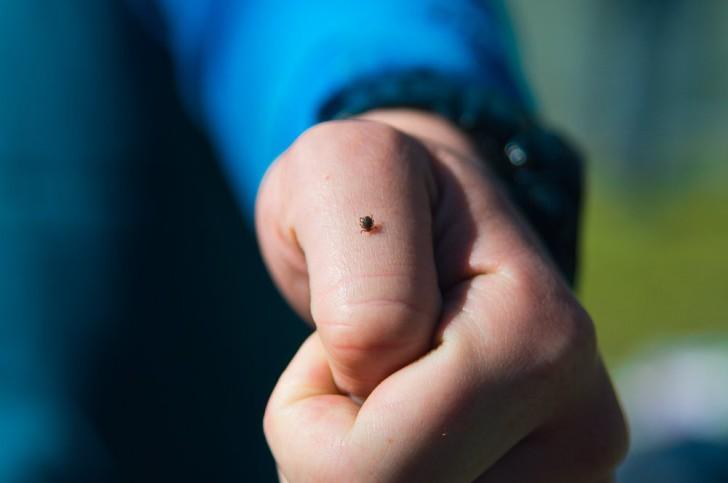

Borreliosis
Forest ticks are the main carriers of such a serious problem as borreliosis, or Lyme disease. Due to the bite of a child by such a dangerous insect, the cells of the central nervous system, skin, heart, and musculoskeletal system soon begin to be affected in a boy or girl.
The signs of this disease are as follows:
- Redness of the skin in the area of the parasite bite.
- Slow increase in the red spot.
- Conversion of the bite site from a rounded speck to a ring with a pale cyanotic nucleus in the center.
What to do if a baby is bitten by a tick, which is a carrier of such a dangerous disease? Parents first of all should call an ambulance, which will take the baby with the mother to the hospital. In the future, the infectious disease doctor will deal with the treatment of the crumbs. Emergency therapy for borreliosis includes taking special medications by the baby, which are prescribed by the doctor.
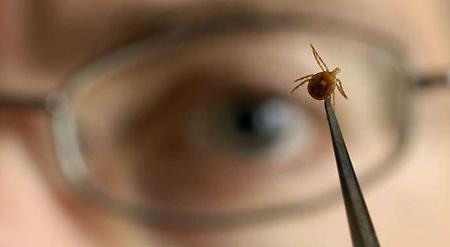

If the mother did not take prompt measures and did not go to the doctor, then the disease will be permanent, which in the future will lead the child to disability.
Tick bite signs and symptoms
After going into a forest or forest-park area, it is recommended to examine the body, especially places that are not covered by clothing. It is believed that the tick sits in the grass and first falls on the feet of a person, and then gradually crawls to where it is attracted by the sensation of blood flow. Most often, parasites are found in the groin, in the abdomen and lower back, under the armpits, on the chest, neck and behind the ear. There are known cases of a bite of infants in the arms of the mother.
READ ALSO: midge bite in children: symptoms with a photo
A tiny black dot that looks harmless may turn out to be a small tick just sucking on the body. Other signs of a bite in the first 2-3 hours, when there is still no reaction from the body, are usually absent. Further, the following manifestations are possible, which will help to understand that the baby has been bitten by a tick:
- temperature rise to 37-38 ° С;
- hypotension;
- heart palpitations;
- rash or redness at the site of the bite, itching;
- an increase in regional lymph nodes (we recommend that you read: what if a child has enlarged lymph nodes in the neck?);
- weakness, drowsiness;
- joint pain.


These signs may appear later - the next day or in a day - and depend on the individual characteristics of the organism. Some people do not feel unwell at all. However, there are those who show severe allergic reactions - choking, headache, vomiting.
What is a tick?
A very small insect, in the mouth apparatus of which there is everything you need to pierce the skin, get to a blood vessel, inject an anticoagulant liquid with saliva and drink blood.
Some ticks are visible to the naked eye and calmly reinforce themselves by grasping the host tightly. And some wield at night and, having eaten, go to their places of permanent habitation until the next meal.
In mild cases the child will get off with a local allergic reaction, in heavy - anaphylaxis may develop (if the body is sensitized by components of the tick's saliva). But in addition to substances physiological for an insect, microorganisms are often contained in its saliva. Some of them are capable of causing encephalitis, typhoid, quarantine (especially dangerous) infections.


Habitat
In our area, the threat is posed by:
- forest;
- bed;
- subcutaneous;
- scabies;
- gamasic (parasitic on the skin of animals);
- argas ("cave").
It turns out that you can pick up a tick anywhere: on a playground, in a park, in a forest, cave or grotto, from domestic or wild animals, birds or even from their nests. Itch itching can be contracted from a sick person by direct or indirect contact.
Favorite bite sites
- Forest and field dwellers affect the skin in secluded places - in the armpits, groin, ears, in the cervical fold. It is these places that need to be examined first of all after walks in nature. The situation is worse if the tick has bitten the child in the scalp. It's much harder to find him here.
- Animal-borne ticks more often they affect the skin of the legs or those parts of the body with which the "puffs" of the hands, neck, face were in contact.
- For bed mites there are no barriers, signs of bites can be found all over the body.
- Scabies itch loves thin skin, as it makes its own moves in it. Therefore, the interdigital zone, the ulnar fossa, armpits, and the abdomen are affected.
The consequences of a tick bite for a child
Do not panic if your child is bitten by a tick. The insect can be quite harmless. If the tick is not a carrier of an infectious disease, the effects of the bite may be absent. It is only important to get rid of the parasite correctly. The greatest danger is posed by insects that carry the following diseases:
- Encephalitis.This condition is caused by a special virus and is characterized by damage to the brain and central nervous system. The disease is extremely difficult, there is a possibility of death.
- Lyme disease caused by bacteria of the genus Borrelia. Sometimes specialists find it difficult to make a diagnosis, since borreliosis can have completely different symptoms. Lyme disease can lead to encephalitis, meningitis, damage to the heart, joints, and nervous system. All stages of the disease (there are only three of them) can proceed for several months, and can last for years.
- Monocytic ehrlichiosis, causing neurological disorders, general intoxication, respiratory diseases.
- Granulocytic anaplasmosis, a disease caused by the bacteria Anaplasma phagocytophillum, can cause kidney damage and meningoencephalitis.
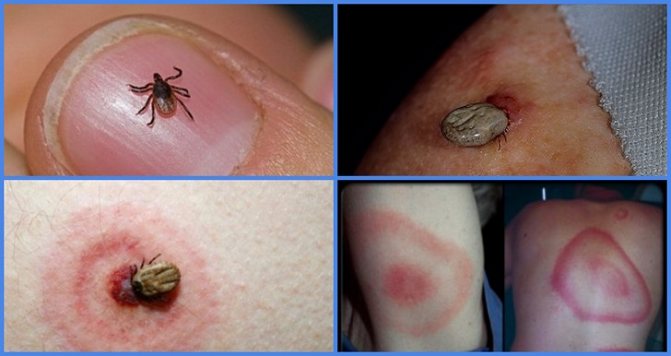

Why tick bites are dangerous
Seemingly absolutely tiny, harmless insects, it is actually very dangerous for the human body. Earning a tick bite, learning about it late is dangerous. The bite of an encephalitis tick can transmit diseases to the human body that are dangerous to humans.
Diseases of encephalitis, Lyme disease, ehrlichiosis, and a number of other transmitted diseases contain ticks in their saliva. Symptoms of encephalitis can be easily confused with the common cold, which is typical for the autumn-spring period. Fever, headache, aching joints, sore throat, dryness of the body, dehydration.
After a couple of days, the condition worsens. Jumps in temperature, aches all over the body, weakness, vomiting. Often accompanied by epilepsy, paralysis. With the rapid detection of a bite, a symptom, the likelihood of curing the victim increases.
Transmitted Lyme disease is accompanied by a temperature-hopping type, vomiting, fragility of the joint. The nervous system is disrupted, the circulatory system fails, the musculoskeletal functions cease to function properly. You can get such a disease from an animal (cat, dog) by drinking contaminated milk from a goat, cow, horse.


Pull out the tick
Eating contaminated meat of animals, chickens, birds, cattle. Examine children after every walk. Coat with sprays, creams, lotions, capsules. Ticks are afraid of white. Wear light-colored clothes on your child in the spring and fall to reduce the risk of a tick bite.
Tick bites cannot always be cured. Even if this is so, defects may remain, the consequences of a bite. Destruction of the nervous system, disorders of the heart, musculoskeletal system. The risk of developing epilepsy, rapid mood swings. Violation of the psyche, the work of the organs of the human body.
For prophylaxis, before going out into the street, sprinkle sopray, spread cream, set fire to a spiral against insects. Walk in a hat, scarf, covering the skin. Before entering the house, shake clothes outside, do not let animals into the house.
Bloodsuckers are by nature sedentary creatures. Parasites cannot jump from branch to branch and climb trees. They don’t need it. Taking a wait-and-see position in dense grass or bush, the tick easily finds its prey. Due to their high susceptibility, bloodsuckers sense the approach of the object of the hunt for 8-10 meters. Preparing for an attack, they raise their front legs and quickly catch on clothing.
Once on the body, ticks can crawl for hours and look for the most successful, from their point of view, place for a bite. If you examine yourself at least once an hour, it is quite possible to detect the parasite even before it bursts into the skin.
If the parasite could not be detected in time, and it has already sucked, you cannot press the bloodsucker on the skin or try to tear it off. If the tick is infected, the infection will still enter the body through the wound and microcracks in the skin. In addition, you will destroy the research object that is supposed to be turned in for
In this case, it is necessary to contact the nearest emergency room as soon as possible to receive medical assistance. If this is not possible at the moment, you should try to independently extract the bloodsucker with the help of available means. At the same time, it is advisable not to tear it apart and pull it out alive.
What to do: first aid
If a child is bitten by a tick, you should act competently and quickly. The sooner assistance is provided, the less likely the consequences are:
- First, you need to pull out the tick, being careful not to damage its head. If it remains in the skin, don't worry too much. After a while, the skin will push out the foreign body on its own.
- The bite mark should be treated with an antiseptic. You can use alcohol, vodka, calendula tincture, iodine, etc.
- It is advisable to place the extracted tick in a container with a lid in order to pass it for examination. Depending on whether the causative agent of a dangerous disease is found in the insect, the doctor will prescribe treatment for the patient.
- It is also recommended to do a blood test to detect antibodies to pathogens carried by ticks.
- Children often have allergies to the bite - reddening of the skin, rash. In this case, you can give the child an antihistamine.
- The main task of parents is to monitor the behavior and condition of the child after the bite. At the slightest sign of malaise, you should immediately seek professional help.
READ ALSO: How to quickly remove swelling from a mosquito bite in a child?
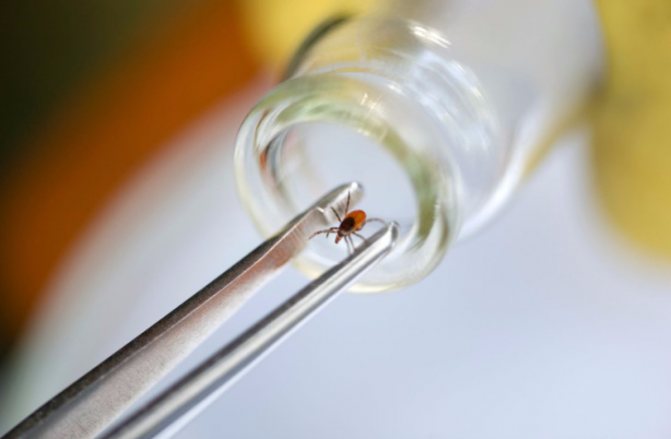

What actions need to be taken
If a situation has occurred that the child is bitten by a tick, a number of actions should be taken that will maximally protect the baby and prevent the severe consequences that an encephalitis tick can bring.
As soon as possible, seek help from a medical institution, where they will help to remove the blood-sucking and will give professional recommendations on the next steps. When it is not possible to see a doctor immediately, you need to remove the parasite yourself. With an independent procedure, it is necessary to follow a number of rules so as not to aggravate the situation.


In order to find out whether an insect is a carrier of infection, the parasite must be tested. This will allow to identify the disease at an early stage, use the correct treatment and prevent development with complications. Remember that children may experience allergic reactions, in which case antihistamines will be required.
It is very important to monitor the baby's health, pay attention to the slightest symptoms and seek medical help right away. The sooner the necessary actions are taken, the easier it will be to cope with the infection.
How to remove a tick at home?
To pull out a sucked tick, special skills are not required. It is advisable to try to remove it with your fingers, taking it by the abdomen. Since the insect knows how to glue its proboscis inside the pore, you should not jerk it sharply. It is better to try to take out with smooth movements, slightly rocking from side to side.
To extract the parasite at home, you can use tweezers (preferably not metal, but plastic) or a thread. To do this, you need to make a loop of the thread and throw it over the proboscis or "neck" of the insect, if it has sunk into the skin. Then cross and pull both ends in the same direction.
However, the best way to extract the parasite is a special tool, which is a bent forked "fork" (pictured). Such a device allows you to remove the insect most accurately, without damaging the head. Experienced tourists recommend taking such a fork with you for a walk in the forest, which will not take up much space in your bag or backpack.
READ ALSO: bed bug bite in children: symptoms with photos and treatment features
Some lubricate the skin around the tick with oil, alcohol, and other substances.According to experts, this should not be done, since such measures will not affect the parasite in any way, but will only complicate its extraction.
READ ALSO: what to do if a child is bitten by a bee?


What category of people is it desirable to buy "Nippes" tweezers
Removing a tick with a thread is not easy, but if you learn how to do it, you can quickly get rid of the insect. If you are trying to do this for the first time, then it is better to immediately abandon the idea. The thread is used only when there is nothing else at hand.
The sequence of actions is as follows:
- Hands are treated with alcohol.
- The thread is applied closer to the tick proboscis.
- Make a knot with slow movements.
- After that, upward movements are made, thus pulling out the parasite. Side manipulation is prohibited.
- Then the tick must be taken to a sanitary station for research.
If it was not possible to remove the tick with the help of a thread or the head remained in the body, then you should not panic. You need to lubricate this place with alcohol and quickly go to the doctor. If you do not have experience in removing a tick, it is better not to risk it, as the consequences of this can be unpredictable.
How to recognize signs of tick-borne encephalitis infection?
Tick-borne encephalitis is the most dangerous disease, the causative agent of which is carried by this parasite. The latency period after infection (encephalitis tick bite) can last from 1 day to a month. The first symptoms of the disease are pronounced. Among them, the following manifestations are possible:
- Strong headache;
- heat up to 39 ° C;
- joint aches;
- the appearance of an unhealthy blush;
- redness of the whites of the eyes.
If, when the first symptoms appear, the patient is not provided with assistance (immediate treatment is required in a hospital setting), then on day 3-4, the first manifestations from the central nervous system are possible. As a rule, these are convulsions, impaired coordination of movements, the appearance of stiff neck muscles (increased muscle tone). The critical period ends a week after the onset of the disease - it is at this moment that in 2-3% of cases death is noted.
Diagnostics
A tick bite can only be identified visually. Laboratory research in this case is pointless. If the bite site changes shape or enlarges, emergency assistance is needed. The specialist will prescribe tests to detect infection with encephalitis and systemic borreliosis only 2 weeks after the incident. Both diseases begin to manifest themselves only 3 weeks after the infection of the child; if infected, the antibiotic "Yodantiprin" is given. In the initial stages, there are no symptoms, so it is advisable to take Anaferon or inject immunoglobulin.
A blood-sucking insect can also infect one of three types of hemorrhagic fever: Crimean Congo, Omsk, or a variety with renal syndrome.
Analyzes of the likelihood of infection are carried out twice with an interval of 2 weeks:
- Blood tests by PCR method on the eleventh day from the moment of the incident to detect Lyme disease and encephalitis;
- Blood tests by ELISA 14 days after the incident to detect infection;
- Blood tests by Western blotting on day 14 for the determination of various types of antibodies to encephalitis and borreliosis disease.
Necessary treatment
A specific treatment for tick-borne encephalitis is the administration of serum with antibodies (immunoglobulin) obtained from the donor's blood.
These substances immediately begin to fight the virus, and also demonstrate a pronounced therapeutic effect. The patient's temperature decreases, headache decreases, and other symptoms disappear. However, the administration of immunoglobulins should be carried out as early as possible after the bite.
If there are signs of damage to the central nervous system, symptomatic treatment is performed. Physicians use corticosteroids and supportive therapies.If suffocation occurs, tracheal intubation is performed and the patient is connected to mechanical ventilation.
What to expect after being bitten?
Bite to bite - strife. After removal of the bloodsucker, events can develop in several directions.
- The tick turned out to be "harmless", i.e. not infected. For the child and the parents, his removal will end with a slight fright.
- The place of contact in an allergic baby will turn red, swelling and itching may appear. A slight malaise and a slight chill, which disappears after a while, complement the general toxic-allergic reaction to the bite.
- The bloodsucker turned out to be the carrier of a dangerous virus (tick-borne encephalitis, Lyme disease, fever, etc.). Each of the infections has its own characteristics. Basically, this is a sharp jump in body temperature, complaints of headache and back pain, loss of appetite, lethargy, changes in the color and shape of the bite site, etc.
Keep a close eye on the tick bite and the baby's well-being
Attention! The weakening of control over the behavior of the child, neglect of protective equipment when walking into the forest, as well as ignoring the baby's complaints about poor health can lead to the development of a serious illness, dangerous not only by damage to the central nervous system, but also by complete paralysis of the body, as well as the death of the bitten one.
Protection against tick bites
In order not to become a victim of diseases carried by forest ticks, you should take care of prevention in advance. To date, there is a vaccine that promotes the development of immunity against the encephalitis virus. Also an important part of preventive measures is the protection of the body from the bite of the parasite, for which various methods are used.
Tick-borne encephalitis vaccinations
Vaccination against encephalitis in children is mandatory indicated for people living in areas with a high risk of infection. If it is decided to vaccinate a child, the scheme should be as follows:
- 1 time the vaccine is administered to the newborn;
- 2 times - every 1-3 months;
- 3 times - in the interval from 9 to 12 months.


After the main phase of immunization, regular revaccination is indicated every 5 years. In this case, protection approaches 100%. Unvaccinated people who are going to visit an endemic area receive unscheduled vaccinations. The injection is done twice with an interval of two weeks.
Other preventive measures
Prevention also includes the following activities:
- Refusal to visit areas where ticks live - forests, fields with tall grass and shrubs. The period from mid-spring (April) to mid-summer (July) is especially dangerous.
- If you are not going to give up the hike, repellents containing diethyltoluamide will help.
- Experts also recommend not to leave open areas of the body. It is best to choose long-sleeved clothes for a forest outing, and tuck trousers into socks.
- It is imperative to examine the body after returning from the forest.
Loading ...
Removal with a syringe
After extracting the parasite, you should not think that the case is complete. It is imperative to treat the wound with an antiseptic. Do not neglect this procedure, otherwise there may be consequences. It is also forbidden to comb the bite site so that the itching does not bother, take an antihistamine and take other measures to eliminate irritation and itching.
The following drugs are suitable for treating wounds:
- Chlorhexidine solution;
- pure alcohol or diluted with water;
- vodka or moonshine;
- hydrogen peroxide;
- Even perfume or eau de toilette will do if there is nothing else at hand.
Processing rules:
- First, the damaged area is treated with light movements using a cotton wool, gauze or other cloth moistened with a solution.
- If in the field nothing was at hand, then pluck a plantain or dandelion, rinse in water and squeeze the juice from the plant onto the wound, then attach a leaf of these plants to the bite site.
- In extreme cases, the wound is washed with clean water and covered with a clean cloth.
- You need to visit a doctor as soon as possible.
- On the way to the doctor, get an antiseptic and treat the affected area.
Going into nature, be sure to take care of essential medicines, these are alcohol, brilliant green or iodine, cotton wool and gauze.
In addition, in the future, you can use antiseptic ointments:
- Sulfur ointment, it relieves inflammation and has an antimicrobial effect. It is applied once every 2 days using a bandage.
- Ichthyol ointment - relieves pain and inflammation, has a keratoplastic effect. Apply it together with a bandage every 8-10 hours.
- "Vetabiol". This ointment is applied 2-3 times a day.
If a tick is found in the human body, do not rush to pull it out of the body. To begin with, you need to process it with peroxide, iodine, brilliant green, alcohol. If you are in a natural environment, you can douse the place with alcohol, vodka, or any other flammable alcoholic substance. After processing, you should sit in a bright place, in a bright room and gently pull the tick out of the body.
A method of pouring burdock, coconut, creamy, almond, citrus fruits (in the absence of allergies) is suitable, the head of the bream will lose its properties, stop sucking, and relax. At this point, you need to carefully pull the tick out of the human body, the sooner the better.
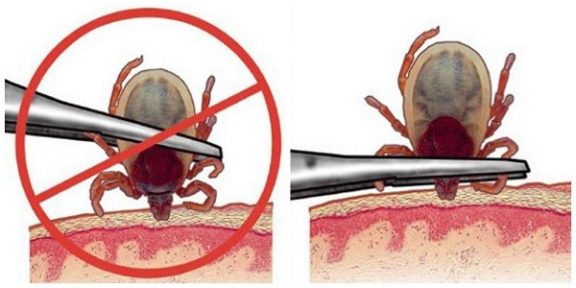

With tongs
Alarming symptoms
In order not to miss the onset of the disease, you need to know what symptoms signal a child's bite with a tick.
At the initial stage:
- body temperature rises to 38-39 ° C;
- the cervical spine becomes painful;
- complaints of headaches, sore eyes;
- disorder of the digestive system.
The course of the disease of moderate severity and severe form is evidenced, in addition to the listed signs, also such:
- nausea, passing into vomiting;
- lack of coordination, dizziness up to loss of consciousness;
- possible paralysis of the limbs, convulsions;
- a severe form of the course of the disease can be fatal.
If the Lyme virus has entered the body, then the bite site in the form of a round spot 3-4 cm in size becomes inflamed and reddens. These signs last from 1 to 30 days. Only after 15 days or a month do secondary symptoms appear: weight loss, nausea, pain throughout the body. The temperature is kept low. The joints of the limbs, neck and back become inflamed. If the disease is ignored or incorrectly diagnosed, the consequences can be irreversible: impaired activity of the central nervous system and cardiovascular system, arthritis.
In any case, the tick must be taken to the laboratory for analysis.


